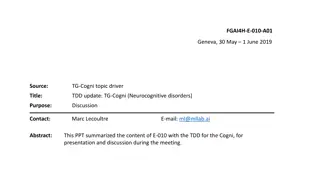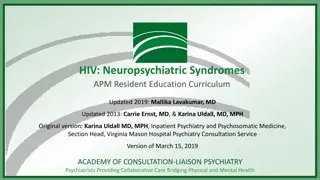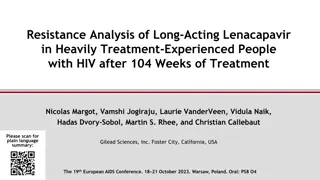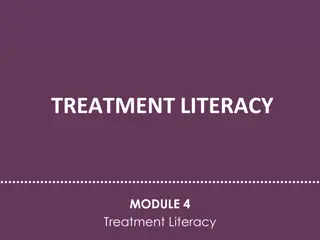Understanding HIV-Associated Neurocognitive Disorders: A Practical Approach
HIV/AIDS presents complex medical and psychiatric challenges, including HIV-Associated Neurocognitive Disorders (HANDs), which impact patients, families, and caregivers. This presentation by Dr. Mary Ann Adler Cohen provides insights into the prevalence, impact, diagnosis, and treatment of HANDs, emphasizing the importance of preventing and managing HIV-associated dementia. With a focus on adherence to treatment and risk reduction, understanding HANDs is crucial in holistic HIV care.
Download Presentation

Please find below an Image/Link to download the presentation.
The content on the website is provided AS IS for your information and personal use only. It may not be sold, licensed, or shared on other websites without obtaining consent from the author. Download presentation by click this link. If you encounter any issues during the download, it is possible that the publisher has removed the file from their server.
E N D
Presentation Transcript
A Practical Approach to HIV-Associated Neurocognitive Disorders Drexel University College of Medicine Division of Infectious Diseases and HIV Medicine Grand Rounds January 16, 2015
Mary Ann Adler Cohen, MD, FACP, FAPM, DLFAPA Clinical Professor of Psychiatry Icahn School of Medicine at Mount Sinai Chair and Founder, Academy of Psychosomatic Medicine HIV/AIDS Psychiatry Special Interest Group Chair and Co-Founder of the World Psychiatric Association Section on HIV/AIDS Psychiatry Former Director, AIDS Psychiatry, Mount Sinai Medical Center Former Director, Consultation-Liaison Psychiatry Service Metropolitan Hospital Center
Disclosure: Mary Ann Adler Cohen, MD With respect to the following presentation, there has been no relevant financial relationship between the party listed above (and/or spouse/partner) and any for-profit company in the past 24 months which could be considered a conflict of interest
Introduction HIV/AIDS: severe, stigmatized, and complex multimorbid medical and psychiatric illnesses with a profound impact on patients, families, and caregivers HIV-Associated Neurocognitive Disorders (HANDs) magnify HIV-associated discrimination and stigma Understanding HANDs can provide you with the tools to prevent and treat HIV-associated dementia
Outline of Presentation Prevalence of HAND and its Impact on Adherence to Risk Reduction, Medical Care, and ART Treatment as prevention of HAND Definition and Classification of Cognitive Disorders and HANDs Controversial Aspects of HANDS: Diagnosis, Screening and Treatment of HAND Clinical Pearls for Treatment of HAND
Prevalence of HAND The prevalence of HIV-associated dementia (HAD) decreased following the development of effective combination antiretroviral therapy (ART) in 1995 In persons with access and adherence to ART, HAD prevalence is estimated to have decreased from 15% (MacArthur et al. 1993) to less than 5% (Heaton et al. 2010) However, there has been little change in the prevalence of asymptomatic neurocognitve impairment (ANI) and mild neurocognitive impairment (MCI) (Tozzi et al. 2007, Simioni et al. 2010) The prevalence of HAND in HIV is about 40 to 50% The work of Heaton, Letendre, Tozzi, Simioni, Cysique, Spudich, and others suggests that the CNS provides an independent reservoir for HIV
Treatment as Prevention: CNS as Independent Reservoir for HIV Replication Starting ARVs as soon as the diagnosis of HIV is made may prevent the development of an independent reservoir for HIV replication in the CNS and thus prevent future development of HAND and HAD Pre-exposure prophylaxis (PrEP) and post-exposure prophylaxis (PEP) can prevent HIV transmission and also can prevent HAND Treatment as prevention of HIV, HAND, and HAD Heaton RK, Franklin DR, Ellis RJ, McCutchen JA, Letendre SL et al. HIV-associated neurocognitive disorders before and during the era of combination antiretroviral therapy: differences in rates, nature, and predictors. J Neurovirol. 2011; 17:3 16 Karim SSA et al. NEJM 2012;367:462 Jay SJ and Gostin LE. JAMA 2012 ;308:867 Marrazzo JM et al. JAMA 2014:312:390.
Prevalence of HAND in the ART Era Cysique LA, MaruffP, Brew BJ. Prevalence and pattern of neuropsychological impairment in human immunodeficiency virus- infected/acquired immunodeficiency syndrome (HIV/AIDS) patients across pre- and post-highly active antiretroviral therapy eras: a combined study of two cohorts. J Neurovirol 2004; 10:350 357 Cysique L, Murray JM, Dunbar M, Jeyakumar V, Brew BJ. A screening algorithm for HIV-associated neurocognitive disorders. HIV Medicine 2010;11:642-649. Heaton R, Franklin D, Clifford D et al. Persistence and progression of HIV-associated neurocognitive impairment (NCI) in the era of combination antiretroviral therapy (CART) and the role of comorbidities: the CHARTER study. 5th International AIDS Society Conference on HIV Pathogenesis, Treatment and Prevention. Cape Town, South Africa. July, 2009. (Abst) Heaton RK, Clifford D, Franklin DR, Woods SP et al. for the CHARTER Group. HIV-associated neurocognitive disorders persist in the era of potent antiretroviral therapy: CHARTER Study. Neurology 2010; 75:2087 2096 Heaton RK, Franklin DR, Ellis RJ, McCutchen JA, Letendre SL et al. HIV-associated neurocognitive disorders before and during the era of combination antiretroviral therapy: differences in rates, nature, and predictors. J Neurovirol. 2011; 17:3 16 Goodkin K, Cahn P, Concha M et al. Prevalence of HIV-1-associated Neurocognitive Disorders in Argentina. 5th International AIDS Society Conference on HIV Pathogenesis, Treatment and Prevention. Cape Town, South Africa. July, 2009. (Abst) Garvey L, Yerrakalva D, Winston A. High rates of asymptomatic neurocognitive impairment (aNCI) in HIV-1 infected subjects receiving stable combination anti-retroviral therapy (CART) with undetectable plasma HIV RNA. 5th International AIDS Society Conference on HIV Pathogenesis, Treatment and Prevention. Cape Town, South Africa. July, 2009. (Abst) Vassallo M, Harvey-Langton A, Malandain G et al. The NeuradaptStudy: Clinical, Radiological and Immunovirologic Findings in Patients with HIV-associated Neurocognitive Disorders. 17th Conference on Retroviruses and Opportunistic Infections. San Francisco, United States of America. February, 2010. (Abst) Ciccarelli N, Fabbiani M, Di Giambenedetto S et al. Prevalence and Correlates of Minor Neurocognitive Disorders in Asymptomatic HIV- infected Outpatients. 17th Conference on Retroviruses and Opportunistic Infections. San Francisco, United States of America. February, 2010. (Abst) Robertson KR, Smurzynski M, Parsons TD, Wu K, Bosch RJ, Wu J,McArthur JC, Collier AC, Evans SR, Ellis RJ. The prevalence and incidence of neurocognitive impairment in the HAART era. AIDS 2007; 21:1915 1921 Royal W, Akomolafe A, Habib A et al. Neurocognitive Impairment and HIV in Nigeria: Functional and Virologic Correlates. 17th Conference on Retroviruses and Opportunistic Infections. San Francisco, United States of America. February, 2010. (Abst) Simioni S, Cavassini M, Annoni JM, Rimbault Abraham A, BourquinI, SchifferV, Calmy A, Chave JP, Giacobini E, Hirschel B, Du Pasquier RA (2010) Cognitive dysfunction in HIV patients despite long-standing suppression of viremia. AIDS 24:1243 1250 Current Estimate is about 40% to 50%
Prevalence of Neurocognitive Impairment in Relation to ART Era
Definitions of Mild Cognitive Syndromes, Dementia, and Delirium Asymptomatic neurocognitive impairment (ANI): Mild to moderate impairment in at least two cognitive domains but without obvious impairment in daily functioning Mild cognitive impairment (MCI): Mild to moderate impairment in at least two cognitive domains that at least mildly interferes with daily activities Dementia: A clinical syndrome not entirely due to delirium consisting of global cognitive decline with several areas being affected and significant impact on daily functioning Delirium: A clinical syndrome of global impairment of cognition especially orientation and attention, including abnormal sleep-wake cycle, thinking, perception, language and affect with acute onset and fluctuating course
Delirium Terms Used Acute brain failure Acute cerebral insufficiency Acute confusional state Encephalopathy Intensive Care Unit (ICU) Psychosis Reversible toxic psychosis
Delirium Subtypes Hyperactive Delirium Hypervigilance Restlessness Fast/loud speech Anger/irritability Combativeness 46% Impatience Uncooperative Laughing Swearing/singing 30% Euphoria Wandering Easy startle Distractibility Nightmares Persistent thoughts Misdiagnosed as psychosis, mania Hypoactive Delirium Unawareness Lethargy Decreased alertness Staring Sparse/slow speech Apathy Decreased motor activity Often misdiagnosed as depression Delirium can be Hyperactive Hypoactive Mixed Superimposed on dementia Meagher, 1996 Liptzin and Levkoff. Br J Psych 1999
Delirium vs. Dementia Delirium Acute or abrupt onset Fluctuation of symptom severity over 24-hour period Reversible when cause is treated Impaired level of consciousness Impaired attention, orientation, memory, executive functions Illusions, hallucinations (visual) Delusions poorly formed, fleeting and paranoid Reversal of sleep-wake cycle, insomnia Affective lability Irritability Hypoactive often misdiagnosed as depression Hyperactive often misdiagnosed as psychosis Dementia Insidious Non-fluctuating Progressive, 85% not reversible Clear level of consciousness unless delirium is superimposed or the dementia is end-stage Impaired memory Can have visual or auditory hallucinations Delusions paranoid and fixed Apathy Apraxia Agnosia Aphasia Amnesia
Signs and Symptoms of Normal Aging versus Dementia Normal Aging and Cognition New onset beginning at age 50 Lack of progression Subjective memory complaints Annoying but not disabling Frequent problems with name retrieval Minor difficulties in recalling detailed events Problems related to overloaded neuronal systems Not associated with any other signs or symptoms May be intermittent Prevalence is estimated at 18% Alzheimer s Dementia Insidious onset Unrelentingly progressive impairment Prominent memory impairment Leading cause of dementia and functional disability in the elderly 50 to 75% of all dementia is Alzheimer s The 4 As of Alzheimer s Dementia: Amnesia, Aphasia, Apraxia, Agnosia Prevalence is 6.5%
Neuropsychological Profile Normal Aging versus Dementia Normal Aging Loss of speed and efficiency of information processing Impaired fluid abilities novel problem-solving Deficiencies in memory retrieval Modest declines in delayed free recall Decrements on executive tests of visuoperceptual, visuospatial, and constructional functions Alzheimer s Dementia Impaired memory consolidation with rapid forgetting Diminished executive skills Impaired semantic fluency and naming Impaired visuospatial analysis and praxis Rapid forgetting of new information after brief delays
Cortical versus Subcortical Dementia Subcortical Dementia 4 Ds Dysmnesia - helped by cues Dysexecutive difficulty with planning and decision-making Delay slow thinking and moving Depletion reduced complexity of thought Affective disorders severe Apathy and inertia Absence of the 4 As Slow diminution of cognitive functions Psychomotor retardation Abnormal gait Loss of initiative, vitality, physical energy and emotional drive Extrapyramidal signs Cortical Dementia 4 As Amnesia - not helped by cues Aphasia Agnosia Apraxia Alexia Affective disorders not frequent Loss of initiative Psychomotor retardation Gait normal until late Extrapyramidal signs - late Pathological reflexes grasp, snout, suck, Babinski - late
Neuropsychological Profile Normal Aging versus Dementia Normal Aging Loss of speed and efficiency of information processing Impaired fluid abilities novel problem-solving Deficiencies in memory retrieval Modest declines in delayed free recall Decrements on executive tests of visuoperceptual, visuospatial, and constructional functions Alzheimer s Dementia Impaired memory consolidation with rapid forgetting Diminished executive skills Impaired semantic fluency and naming Impaired visuospatial analysis and praxis Rapid forgetting of new information after brief delays
Definition and Classification of HIV-Associated Neurocognitive Disorders (HANDs) Asymptomatic Neurocognitive Impairment ANI mild to moderate impairment in at least 2 domains without obvious impairment in daily functioning Mild Neurocognitive Impairment MCI mild to moderate impairment in at least 2 domains with at least mild interference with daily functioning HIV-Associated Dementia HAD a subcortical and cortical dementia that is severe enough to cause functional impairment and is characterized by slowed information processing, deficits in attention and memory, and impairments in abstraction and fine motor skills
HIV-Associated Neurocognitive Profile Fronto-subcortical pattern in the following domains: Attention / Working Memory Executive Functioning Information Processing Speed Verbal Fluency Learning Motor Function Verbal Memory
Differentiating Delirium from HIV- Associated Dementia
Clinical Pearls for Differential Diagnosis of Psychiatric Symptoms in HIV and AIDS There is a need for a comprehensive biopsychosocial approach to psychiatric symptom evaluation in persons with HIV/AIDS This comprehensive approach to differential diagnosis includes exploring clues for infectious, neurologic, and psychiatric causes and requires complete medical, psychiatric, and psychosocial assessments as well as ancillary evaluations Delirium is prevalent in inpatient medicine and may be superimposed on HIV-associated dementia Cohen, 1987, 1992; Cohen et al., 2010; Cohen and Alfonso, 2004; Cohen and Chao,2008; Cohen and Gorman, 2008; Cohen and Weisman, 1986, 1988; Peterson et al. J Am Geriatr Soc 2006; Pandharipande et al. IntensiveCare Med, 2007; Khurana et al Geriatr Gerontol Int, 2011
Clinical Pearls for Prevention and Recognition of HANDs Each person with HIV needs a complete cognitive assessment at baseline and on a semi-annual or at least annual basis and whenever there is evidence of a change in cognitive function HIV-associated dementia can be prevented by early diagnosis of HIV infection and initiation of antiretroviral therapy immediately upon exposure to or diagnosis of HIV HAND can be prevented by pre-exposure (PrEP) prophylaxis and post-exposure prophylaxis (PEP) Cognitive impairment can contribute to nonadherence at any age or stage of HIV infection
Clinical Pearls for Prevention and Recognition of Cognitive Disorders Antiretroviral therapy may prevent HAND, prevent HAND progression, and, at times, reverse cognitive impairment HAND is still prevalent and is the most common treatable cause of dementia in persons under 50 years of age (Ances and Ellis, 2007) Hypoactive delirium is prevalent in persons with HIV and AIDS, can masquerade as depression, can be superimposed on HIV-associated dementia, and is easily resolved if or when the underlying cause is identified and treated
Risk Factors for HAD Older age History of CNS disease Shorter duration of antiretroviral treatment Low CD4 (current and nadir) Asymptomatic neurocognitive impairment (ANI) Mild neurocognitive impairment (MCI) Co-infection with hepatitis C (HCV) Insulin resistance, cardiovascular illnesses, metabolic syndrome Seroconversion disorder Anemia Vitamin deficiencies (B6, B12) High CSF viral load Depression Alcohol, amphetamines, cocaine Valcour V, Sacktor N, Paul R et al. Insulin resistance is associated with cognition among HIV-1- infected patients: the Hawaii Aging with HIV cohort. J Acquir Immun Defic Syndr 2006;43:405-410. Cysique L, Murray JM, Dunbar M, Jeyakumar V, Brew BJ. A screening algorithm for HIV-associated neurocognitive disorders. HIV Medicine 2010;11:642-649.
Alzheimers Dementia (AD) versus HIV-Associated Dementia (HAD) Note Overlap AD Age over 65 years Insidious onset Unrelentingly progressive impairment Prominent memory impairment Amnesia Aphasia Apraxia Agnosia Impaired semantic fluency and naming Impaired visuospatial analysis and praxis Rapid forgetting of new information after brief delays May have incontinence May have cortical release signs HAD Can occur at any age over 18 Can be prevented Can be reversed with antiretrovirals Cognitive slowing Psychomotor slowing Impaired attention and concentration Impaired impulse control Impaired executive function Apathy Regression Psychosis Mood disorders Dropping things Impaired balance Ataxia, tremor Incontinence can occur late
What is Your Diagnosis of Mr. As Cognitive Impairment? Mr. A is a 64 year old with AIDS diagnosed in 1997 when he was found to have late-stage AIDS and a CD4 of 17 who self-referred in 2012 because of memory impairment, difficulty retaining new information, and multitasking Fluent in Greek, Russian, Italian, Portuguese, Spanish, French, and English, he resigned from his job at an international firm because he himself noticed that he was making mistakes He mourns both the loss of his job and the loss of his excellent memory that was once a source of great pride
What is the Differential Diagnosis of Mr. A s Memory Impairment?
What is the Differential Diagnosis of Mr. A s Memory Impairment? Delirium Mood disorder with depressive features Substance use disorder Mr. A had no evidence of delirium, depression, or substance use MMSE is 30 and his clock and Bender drawings, formal tests of recall, registration, Mental Alternation Test (verbal Trailmaking), similarity testing, proverb interpretation, and serial 7s are all within normal limits
What is the Diagnosis of Mr. As Memory Impairment? His own complaints and validation by collateral informants suggest that his diagnosis is probably consistent with HIV-associated mild neurocognitive impairment (MCI) however, since he performed well on cognitive testing and did not have NP testing we cannot make this diagnosis. There is a need for a complete comprehensive cognitive assessment of persons with HIV/AIDS, better criteria for diagnosis of HAND, and at times for neuropsychological testing.
HIV/AIDS: A Paradigm for Comprehensive and Compassionate Care with a Biopsychosocial Approach Complex and severe medical and psychiatric illness Persons with HIV/AIDS are vulnerable Medically Psychiatrically Socially Cohen MA and Gorman JM. Comprehensive Textbook of AIDS Psychiatry. Oxford University Press, New York, 2008 Cohen MA, Goforth HW, Lux JZ, Batista SM, Khalife S, Cozza KL, and Soffer J. Handbook of AIDS Psychiatry. Oxford University Press, New York, 2010.
Severe Multisystem Illness Cardiac Dermatological Endocrinological GI Infectious Neurological Oncological Ophthalmologic Psychiatric Pulmonary Renal Taboo Topics Sex Trauma Drugs Infection Death Stigmatized Illness Hepatitis C STDs TB PTSD Dementia Delirium Psychosis Injecting Drug Use HIV/AIDS Psychiatry Prevention Barrier contraception Drug treatment Safe sex Sterile works Trauma prevention Lethalit y Adherence to Prevention and Treatment Men who have sex with men African- American Latino- American Addicted Children Elderly Women Vulnerable Populations
Need for Recognition and Treatment of Psychiatric Disorders Vectors of HIV Barriers to adherence Psychiatric treatment: transmission, morbidity, mortality, suffering adherence
Adherence Need 95% adherence to ARVs Need 100% adherence to safer sex Need 100% adherence to use of sterile works In the USA, only 29% of persons with HIV and on ARVs have achieved viral suppression Only 69% are linked to care and 59% are retained in care Thompson MA et al. Guidelines for improving entry into and retention in care and antiretroviral adherence for persons with HIV: evidence-based recommendations from an international association of physicians in AIDS care panel. Ann Intern Med 2012; 156:817-833
Adherence to Appointments and Mortality in Persons with HIV Mugavero and colleagues found that adherence to HIV clinic appointments is an independent predictor of all-cause mortality in persons with HIV Mugavero MJ et al. Beyond Core Indicators of Retention in HIV Care: Missed Clinic Visits are Independently Associated with All cause Mortality. Clinical Infectious Diseases 2014; 59:1471- 1479
Tragic Results of Psychiatric Barriers to Adherence Lack of access to care Nonadherence to care Stopping and starting ARVs Emergence of viral mutations and viral multidrug resistance Development of independent CNS reservoirs Dying of AIDS and other causes of mortality in persons with HIV
What Psychiatric Disorder is a Factor in Mr. B s Refusal to Remain in a Nursing Home? Mr. B is a 37 year old disabled former investment banker with AIDS (CD4 112 and elevated viral load) who was admitted to a nursing home when he was no longer able to care for himself in the community or perform activities of daily living (ADLs) or instrumental ADLs (IADLs). He was referred for refusal to stay in the nursing home. Mr. B s history revealed that he was no longer able to care for his partner or himself, wandered away from their apartment and got lost, and did not believe that he was ill or that he had AIDS.
Diagnosis and Treatment of Mr. B On initial psychiatric consultation Mr. B denied being ill or needing care. He wanted to return home to live with his partner. What is your diagnosis?
Diagnosis and Treatment of Mr. B On initial psychiatric consultation Mr. B denied being ill or needing care. He wanted to return home to live with his partner. He had impairment of memory, abstract thinking, planning, and executive function. Mr. B had anosognosia, constructional apraxia on clock and Bender drawings, psychomotor retardation, and profoundly diminished intellectual functioning relative to his educational (MBA) and occupational levels. He was incontinent of urine and feces.
Diagnosis and Treatment of Mr. B Mr. B met criteria for HIV-associated dementia (HAD). After two years of directly administered ART in the nursing home setting, evidence of HAD could not be detected on psychiatric examination. Mr. B was able to resume independent living and went from disabled young man in diapers to dapper investment banker. Dementia can occur at any age in persons with HIV infection. Early treatment with ART and early recognition of HAND can lead to decrease or resolution of cognitive impairment and restoration of function in some persons with HIV/AIDS.
Diagnosis and Treatment of HAND This vignette illustrates that although ART has had a major impact on both morbidity and mortality in persons with AIDS, HAND is still prevalent and is the most common treatable cause of dementia in persons under 50 (Ances and Ellis, 2007) It is important to diagnose HIV infection early and begin ART, since there is evidence that HIV has an affinity for neural tissue and can establish independent reservoirs in the brain Every person with HIV infection needs a comprehensive evaluation for cognitive impairment at baseline and at least twice yearly to ensure early diagnosis and of HAND Comprehensive psychiatric assessment for HAND and other psychiatric disorders in persons with HIV and AIDS is described in the Handbook of AIDS Psychiatry HAND is a prevalent diagnosis young persons as well as in elderly persons with HIV/AIDS
HIV-Associcated Neurocognitive Disorder (HAND) HAND is found in 69% of virally suppressed persons with HIV (Simioni et al. 2010) Current estimates of HAND prevalence is 40% - 50% (CHARTER 2014) Neurocognitive disorders can resemble depression and are seldom diagnosed Diagnosis requires complete cognitive assessment but brief screening can help lead to diagnosis HAD leads to nonadherence with HIV care HAD may reverse with ART Once treated, adherence improves, preventing illness progression
Screening for HIV-Associated Neurocognitive Disorders (HAND) The gold standard is a full battery of neuropsychological testing administered by a neuropsychologist Unavailable in most clinical settings Often available only as part of a research study Unavailable in resource-limited settings Efforts are made to develop reliable and valid screening tools but no screening tool has been identified thus far
HIV-Associated Neurocognitive Disorders: Screening with Simioni Questions Do you experience frequent memory loss - do you forget the occurrence of special events even the more recent ones? Do you feel that you are slower when reasoning, planning activities, or solving problems? Do you find it more difficult to perform activities that used to be automatic for you (paying bills, writing checks, making plans) Do you have difficulties paying attention (to a conversation, a book, or a movie)? Do you have difficulty with complex learned tasks that were previously easy for you (playing the piano, speaking a second language, knitting a sweater)? Simioni et al, AIDS 2010 - adapted with additions
HIV-Associated Neurocognitive Disorders: The Use of Screening Tools is Controversial The HIV Dementia Scale (HDS) was developed to screen for HAD The International HIV Dementia Scale (IHDS) was developed for global use The Montreal Cognitive Assessment (MoCA) was developed to screen for HAND but reliability and validity are not adequate Power C, Selnes OA, Grim JA, McArthur JC. HIV Dementia Scale: a rapid screening test. J Acquir Immune Defic Syndr Hum Retrovirol 1995; 8:273 278 Sacktor NC, Wong M, Nakasujja N, Skolasky RL, Selnes OA, Musisi S, et al. The International HIV Dementia Scale: a new rapid screening test for HIV dementia. AIDS 2005; 19:1367 1374 Koski L, Brouillette MJ, Lalonde R, Hello B, Wong E, Tsuchida A, et al. Computerized testing augments pencil-and-paper tasks in measuring HIV-associated mild cognitive impairment. HIV Med 2011; 12:472 480
HIV-Associated Neurocognitive Disorders: The Use of Screening Tools is Controversial Zipursky AR et al. Evaluation of brief screening tools for neurocognitive impairment in HIV/AIDS: a systematic review of the literature. AIDS 2013; 27:2385 2401. There is no adequate, reliable, valid screening tool for the diagnosis of HAND
Controversy in Diagnosis of HAND No reliable and valid screening instrument has been developed as yet The best approach is neuropsychological testing can be abbreviated and utilized Do not use the Mini Mental State Examination Can use the Simioni questions and clock drawing for a baseline and semiannual assessment
Controversy in Treatment of HAND: How Important is CPE Rank? Initially thought to be important, the ability of ART to cross the blood brain barrier, or the CNS penetration effectiveness (CPE) rank is now in question Is lowering CNS viral load correlated with clinical improvement? Letendre S et al. Arch Neurol 2008;65:65 Caniglia EC et al. Neurology 2014 Ellis RJ et al. CID 2014;58:1015.
Treatment of Psychiatric Disorders in Persons with HAND Crisis Intervention Individual psychodynamic psychotherapy Supportive psychotherapy Cognitive behavioral therapy Group psychotherapy Couple therapy Family therapy Bereavement therapy Substance use treatment Palliative psychiatry Psychoeducational approaches to prevention Psychopharmacology
Treatment of Psychiatric Disorders in Persons with HAND: Support Groups Provide a safe environment to discuss concerns about HIV, its stigma, and its treatments Provide support from both members and leaders Confidential Non-judgmental Compassionate Caring All in the same boat Acceptance and sense of family























